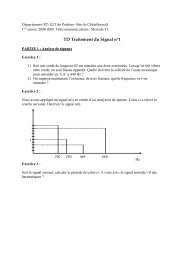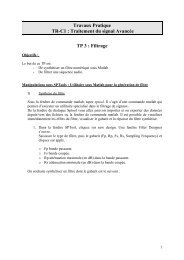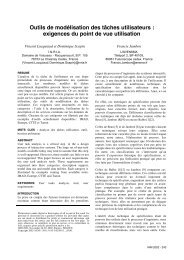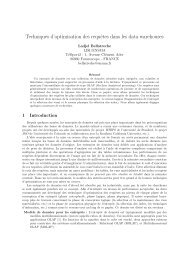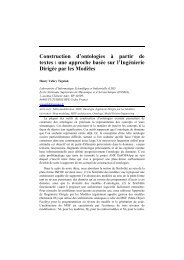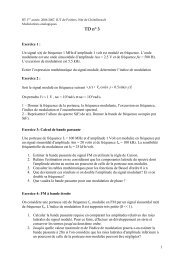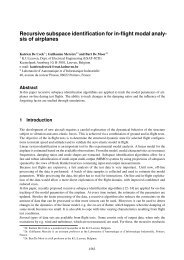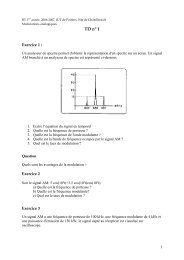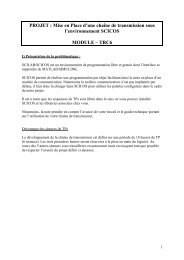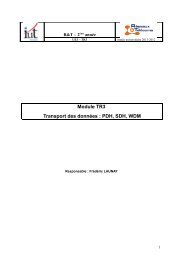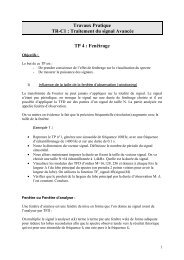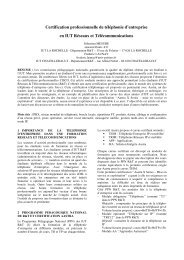Comparison of two worst-case response time analysis ... - LIAS
Comparison of two worst-case response time analysis ... - LIAS
Comparison of two worst-case response time analysis ... - LIAS
You also want an ePaper? Increase the reach of your titles
YUMPU automatically turns print PDFs into web optimized ePapers that Google loves.
<strong>Comparison</strong> <strong>of</strong> <strong>two</strong> <strong>worst</strong>-<strong>case</strong> <strong>response</strong> <strong>time</strong> <strong>analysis</strong> methods for<br />
real-<strong>time</strong> transactions<br />
A. Rahni, K. Traore, E. Grolleau and M. Richard<br />
LISI/ENSMA<br />
Téléport 2, 1 Av. Clément Ader<br />
BP 40109, 86961 Futuroscope Chasseneuil Cedex<br />
{rahnia,traore,grolleau,richardm}@ensma.fr<br />
Abstract<br />
This paper presents a comparison <strong>of</strong> <strong>two</strong> <strong>worst</strong><br />
<strong>case</strong> <strong>response</strong> <strong>time</strong> <strong>analysis</strong> methods in the context <strong>of</strong><br />
transactions. In the general context <strong>of</strong> tasks with <strong>of</strong>fsets<br />
(general transactions), only exponential methods<br />
are known to calculate the exact <strong>worst</strong>-<strong>case</strong> <strong>response</strong><br />
<strong>time</strong> <strong>of</strong> a task. We focus more precisely on monotonic<br />
transactions. In this context, we present the fast<br />
and tight <strong>analysis</strong>, proposed in [7, 6], and the <strong>analysis</strong><br />
technique <strong>of</strong> monotonic transaction that we have<br />
proposed in [14]. We compare them on a <strong>case</strong> study<br />
and on several configurations generated randomly.<br />
Keywords: Response Time, Transactions<br />
1. Introduction<br />
The Response-Time Analysis [1] is an essential<br />
<strong>analysis</strong> technique that can be used to perform<br />
schedulability tests. Tindell proposed in [11] a new<br />
model <strong>of</strong> tasks with <strong>of</strong>fset (transactions) extending<br />
the model <strong>of</strong> Liu and Layland [5]. Since the transactions<br />
are non-concrete(the transaction release <strong>time</strong>s<br />
are not fixed a priori), the main problems is to determine<br />
the <strong>worst</strong> <strong>case</strong> configuration for a task under<br />
<strong>analysis</strong> (its critical instant). Tindell showed that the<br />
critical instant for a task under <strong>analysis</strong> (τ ua ) occurs<br />
when one task <strong>of</strong> higher priority in each transaction<br />
is released at the same <strong>time</strong> as τ ua .<br />
An exact calculation method has been proposed<br />
in [10], but has an exponential complexity and is<br />
intractable for realistic task systems; Tindell [11]<br />
has proposed a pseudo-polynomial approximation<br />
method providing an upper bound <strong>of</strong> the <strong>worst</strong>-<strong>case</strong><br />
<strong>response</strong>-<strong>time</strong>. Later, this approach has been improved<br />
in [4, 6, 7, 8]<br />
In the sequel, we present the model <strong>of</strong> tasks with<br />
<strong>of</strong>fsets (a.k.a. transaction), then we present the best<br />
known approximation method proposed by Turja and<br />
Nolin [8]. Section 4 presents the monotonic transactions<br />
exact <strong>analysis</strong> [13] and these <strong>two</strong> methods are<br />
used on the same tasks system. In the last section<br />
their performance are compared on randomly generated<br />
transaction systems.<br />
2. Model <strong>of</strong> transactions<br />
A tasks system Γ is composed <strong>of</strong> a set <strong>of</strong> |Γ| transactions<br />
Γ i , with 1 ≤ i ≤ |Γ i | (where |Γ i | is the number<br />
<strong>of</strong> elements in the set Γ i ).<br />
{ }<br />
Γ : Γ1 , Γ 2 , .., Γ |Γ|<br />
{ }<br />
Γ i : τi1 , τ i2 , ..., τ i|Γi|, T i<br />
τ ij : < C ij , O ij , D ij , J ij , B ij , P ij ><br />
Each transaction Γ i (see figure 1) consists <strong>of</strong> a set<br />
<strong>of</strong> |Γ i | tasks τ ij released at the same period T i , with<br />
0 < j ≤ |Γ|. Without loss <strong>of</strong> generality, we suppose<br />
that the tasks are ordered in the set by increasing<br />
<strong>of</strong>fset. A task τ ij is defined by : a <strong>worst</strong>-<strong>case</strong> execution<br />
<strong>time</strong> (WCET) C ij , an <strong>of</strong>fset O ij related to the<br />
release date <strong>of</strong> the transaction Γ i , a relative deadline<br />
D ij , a maximum jitter J ij (the activation <strong>time</strong><br />
<strong>of</strong> task τ ij may occur at any <strong>time</strong> between t 0 + O ij<br />
and t 0 + O ij + J ij , where t 0 is the release date <strong>of</strong> the<br />
transaction Γ i , a maximum blocking factor B ij due<br />
to lower priority tasks (e.g. priority ceiling protocol<br />
[9]), and P ij is its priority (we assume a fixed-priority<br />
scheduling policy). The figure 1 presents an example<br />
<strong>of</strong> transaction Γ i composed <strong>of</strong> three tasks with period<br />
T i = 16.<br />
Let us note hp i (τ ua ) the set <strong>of</strong> indices <strong>of</strong> the tasks <strong>of</strong><br />
Γ i with a priority higher than the priority <strong>of</strong> a task<br />
under <strong>analysis</strong> τ ua , assuming that the priorities <strong>of</strong> the<br />
tasks are unique.<br />
3 Fast and Tight Analysis<br />
This method provides an efficient implementation<br />
to calculate an upper-bound <strong>of</strong> the <strong>worst</strong>-<strong>case</strong> <strong>response</strong><br />
<strong>time</strong>s [7]. The main idea is to represent the<br />
periodic interference function statically, and during
f<br />
r<br />
f<br />
g<br />
τ τ<br />
W%(τ&',t )<br />
Figure 1. Example <strong>of</strong> transaction.<br />
Γ<br />
Γ ¡¢£¤ ©¡¦ ©¡<br />
O§ © ¡<br />
τ ¡<br />
the <strong>response</strong>-<strong>time</strong> calculation, to use a simple lookup<br />
function in order to compute its value. The interference<br />
imposed by the transaction Γ i on a task under<br />
<strong>analysis</strong> τ ua during a busy period <strong>of</strong> length t starting<br />
at the release <strong>of</strong> τ ua and corresponding to the release<br />
<strong>of</strong> τ ic is noted W ic (τ ua , t) (τ ic is then called the critical<br />
instant candidate in Γ i ). In order to simplify, we<br />
suppose no Jitter in the transaction (i.e J ij = 0).<br />
¥¡¦O§¨<br />
W ic (τ ua, t) =<br />
τ<br />
τ τ<br />
τ τ<br />
∑<br />
j∈hp i (τ ua)<br />
t ∗ = t − Φ ijc<br />
((⌊ t ∗ ⌋ )<br />
)<br />
+ 1 ∗ C ij − x ijc (t)<br />
T i<br />
Φ ijc = (T i + (O ij − O ic )) % T i<br />
{ 0 for t<br />
x ijc (t) =<br />
∗ < 0<br />
max(0, C ij − (t ∗ % T i )) otherwise<br />
Φ ijc is the phase between τ ic and τ ij . x ijc (t) corresponds<br />
to the part <strong>of</strong> the task τ ij that cannot be<br />
executed in the <strong>time</strong> interval <strong>of</strong> length t (note that<br />
this part is the main difference between the methods<br />
presented in [4] and [7]).<br />
In order to find the critical instant, one would have to<br />
compare every combination <strong>of</strong> critical instant candidates,<br />
making the exact test intractable. The fast and<br />
tight <strong>analysis</strong> method consists <strong>of</strong> creating a global interference<br />
function W i (τ ua , t) for each transaction Γ i ,<br />
in choosing the maximum value <strong>of</strong> each interference<br />
function.<br />
W i (τ ua , t) =<br />
max W ic(τ ua , t)<br />
∀c∈hp i(τ ua)<br />
The figure 2 shows the graphical representation <strong>of</strong><br />
the interference <strong>of</strong> a transaction : each curve represents<br />
the interference function for each critical instant<br />
candidate. Since the transaction is in normal form,<br />
the derivative <strong>of</strong> each curve is either 0 or 1. W i (τ ua , t)<br />
that has to be computed is the maximum <strong>of</strong> all the<br />
curves. The efficient implementation proposed in [7]<br />
stores the set <strong>of</strong> points P ic , where each point P ic [k]<br />
has an x (representing <strong>time</strong>) and a y (representing<br />
interference) coordinate. These points correspond to<br />
the convex corners <strong>of</strong> the curve W ic (τ ua , t).<br />
The calculation <strong>of</strong> the upper bound on the <strong>worst</strong>-<strong>case</strong><br />
<strong>response</strong> <strong>time</strong> R ua <strong>of</strong> τ ua is obtained by an iterative<br />
Figure 2. Interference <strong>of</strong> transaction.<br />
!" τ<br />
#$ #<br />
fix-point lookup.<br />
R 0 ua = C ua<br />
R (n+1)<br />
ua<br />
= C ua + ∑ Γ i∈Γ<br />
(W i (τ ua , R n ua )) (1)<br />
where W i (τ ua , t) is deduced from the static representation<br />
<strong>of</strong> the transactions interferences.<br />
3.1 Normal form <strong>of</strong> a transaction<br />
Without loss <strong>of</strong> generality, we consider that all the<br />
tasks <strong>of</strong> Γ i have a higher priority than the task under<br />
<strong>analysis</strong> τ ua . Since some tasks <strong>of</strong> a transaction may<br />
have to overlap, issuing in an interference function<br />
which derivative would be greater than 1, a normal<br />
form <strong>of</strong> the transaction is first obtained using three<br />
operations: order, merge, and split [7]. For each critical<br />
instant candidate τ ic , the transaction Γ i is put in<br />
normal-form. We start with all the tasks numbered<br />
in increasing Φ ijc (phase between τ ij and τ ic ). Thus<br />
the task τ ic in the original transaction is named τ i1<br />
at the beginning <strong>of</strong> the normal-form processing.<br />
The underlying idea behind the merge operation is<br />
that if <strong>two</strong> tasks τ ij and τ ij+1 overlap, then the<br />
longest busy period initiated by τ ij is always including<br />
the longest busy period initiated by τ ij+1 . The<br />
split operation is used when a part <strong>of</strong> a task has to be<br />
executed during the next period <strong>of</strong> the transaction :<br />
in this <strong>case</strong> the spilling task is splitted into <strong>two</strong> tasks.<br />
The spilling part is taken into account as a task with<br />
an <strong>of</strong>fset equal to 0 in the second period <strong>of</strong> the transaction.<br />
Thus, since the tasks are numbered according<br />
to the increasing value <strong>of</strong> Φ ijc , the tasks can be renumbered<br />
(ordering operation) in the second period<br />
<strong>of</strong> the transaction. These operations are used until<br />
no task in the transaction is forced to overlap on the<br />
next one, and until no task is forced to spill in the<br />
second period <strong>of</strong> the transaction.<br />
Note that the first period <strong>of</strong> a transaction may differ<br />
in the number <strong>of</strong> tasks from the second period due to<br />
the spilling tasks.<br />
Note that if a jitter has to be taken into account, this<br />
operation has to be done for every critical instant<br />
2
candidate.<br />
3.2 Example<br />
We apply this method on the transaction Γ i that<br />
contains twelve tasks with no jitter (J ij = 0). and the<br />
task τ ua with a WCET C ua = 9 and a lower priority<br />
than all the tasks <strong>of</strong> Γ i .<br />
Γ i := {< τ i1τ i2, ..., τ i12 >,60}<br />
τ i1 :< 3, 1, D i1, 0,0, 1 > τ i7 :< 2, 36, D i7,0, 0,7 ><br />
τ i2 :< 4, 9, D i2, 0,0, 2 > τ i8 :< 5, 43, D i8,0, 0,8 ><br />
τ i3 :< 2,11, D i3, 0,0, 3 > τ i9 :< 3, 46, D i9,0, 0,9 ><br />
τ i4 :< 3,20, D i4, 0,0, 4 > τ i10 :< 1,49, D i10,0, 0,10 ><br />
τ i5 :< 4,29, D i5, 0,0, 5 > τ i11 :< 4,56, D i11,0, 0,11 ><br />
τ i6 :< 5,31, D i6, 0,0, 6 > τ i12 :< 2,57, D i12,0, 0,12 ><br />
Obtaining the normal-form for Γ i for the critical<br />
instant candidate τ i1 : the three operations (order,<br />
merge and spill), merge τ i3 in τ i2 , τ i6 and τ i7 in τ i5 ,<br />
τ i9 and τ i10 are merged in τ i8 , and τ i11 is merged in<br />
τ i12 . The last task spills in the next period, thus the<br />
second period <strong>of</strong> the transaction (and the following)<br />
will have a additional task The resulting transaction<br />
in normal-form, for the first period is:<br />
τ i1 :< 3,0, D i1,0,0, 1 > τ i2 :< 6,8, D i2,0, 0,2 ><br />
τ i3 :< 3, 19, D i3,0,0, 3 > τ i4 :< 11, 28, D i4,0,0, 4 ><br />
τ i5 :< 9, 42, D i5,0,0, 5 > τ i6 :< 5,55, D i6,0, 0, 6 ><br />
For the second period, the spilling <strong>time</strong> <strong>of</strong> the original<br />
τ i12 is taken into account in the first task τ i1 <strong>of</strong> the<br />
second period <strong>of</strong> the transaction, obtaining a WCET<br />
<strong>of</strong> 4.<br />
τ i1 :=< 4, 0, D i1,0, 0,1 > τ i2 :=< 6,8, D i2,0, 0,2 ><br />
τ i3 :=< 3,19, D i3,0, 0,3 > τ i4 :=< 11, 28, D i4,0, 0,4 ><br />
τ i5 :=< 9,42, D i5,0, 0,5 > τ i6 :=< 5,55, D i6,0,0, 6 ><br />
The same operation is done for all the task<br />
candidates τ ic for c = 2..12. The upper bound <strong>of</strong><br />
the <strong>worst</strong>-<strong>case</strong> <strong>response</strong> <strong>time</strong> is then obtained using<br />
formula 1:<br />
Iteration 0 : R 0 ua = 9<br />
Iteration 1 : t = 9 : R 1 ua = 9 + 11 = 20<br />
Iteration 2 : t = 20 : R 2 ua = 9 + 20 = 29<br />
Iteration 3 : t = 29 : R 3 ua = 9 + 29 = 38<br />
Iteration 4 : t = 38 : R 4 ua = 9 + 29 = 38<br />
4 Monotonic Transactions<br />
In this section we present the different steps <strong>of</strong><br />
monotonic transaction <strong>analysis</strong> [13, 14, 12]. Monotonic<br />
transaction <strong>analysis</strong> relies on transactions for<br />
which one interference curve (for one candidate) is<br />
always greater or equal than the other curves. In<br />
this way, it’s close to the concept <strong>of</strong> accumulatively<br />
monotonic generalized multiframe task sets [2]. In<br />
this <strong>case</strong>, if a transaction Γ i is monotonic then the<br />
critical instant occurs when the task under <strong>analysis</strong><br />
is released at the same <strong>time</strong> as the first task <strong>of</strong> the<br />
pattern <strong>of</strong> the normal form <strong>of</strong> Γ i . Therefore, for the<br />
<strong>case</strong> where all the transactions <strong>of</strong> the task system are<br />
monotonic for a task under <strong>analysis</strong>, the computed<br />
<strong>worst</strong>-<strong>case</strong> <strong>response</strong> <strong>time</strong> is exact.<br />
Since there is only one possible candidate in a<br />
monotonic transaction, there is only one normal-form<br />
to compute.<br />
4.1 Finding the monotonic pattern<br />
Let Γ ∗ i be<br />
{<br />
the normal form <strong>of</strong><br />
}<br />
the transaction Γ i<br />
where Γ ∗ i :< τi1 ∗ , τ i2 ∗ , ..., τ i|Γ ∗ ∗|, T i , T i > and Γ i :<<br />
{ }<br />
i<br />
τi1 , τ i2 , ..., τ i|Γi|, T i , Ti >. Let us note:<br />
α ij = O ∗ i(j+1) − (O∗ ij + C ∗ ij) for 1 ≤ j < |Γ ∗ i |<br />
α i|Γ ∗<br />
i | = (T i + O ∗ i1 ) − (O∗ i|Γ ∗ i | + C∗ i|Γ ∗ i |)<br />
where α ij > 1 since Γ ∗ i is in normal form.<br />
Note that since it’s not necessary to statically store<br />
the interference function, there is no need to make a<br />
difference between the first and the second period <strong>of</strong><br />
the transaction.<br />
Γ i is a monotonic transaction for the task τ ua (we<br />
consider that all the tasks <strong>of</strong> Γ i have a higher priority<br />
than the one <strong>of</strong> τ ua ) if the WCET <strong>of</strong> the tasks <strong>of</strong> Γ ∗ i<br />
have decreasing values while the idle slots α ij have<br />
increasing values i.e: Ci(p+1) ∗ ≤ C∗ ip for all 1 ≤ p <<br />
|Γ ∗ i | and α ip ≤ α i(p+1) for all 1 ≤ p < |Γ ∗ i |.<br />
Γ i is monotonic if we can find a monotonic pattern<br />
in Γ ∗ i by rotating the tasks <strong>of</strong> Γ∗ i . We know that for<br />
a monotonic pattern the first task has the highest<br />
WCET. In order to look for a monotonic pattern, we<br />
start by inventorying all the tasks with the maximum<br />
WCET. Then, we consider alternatively each <strong>of</strong> these<br />
tasks τik ∗ as the first task <strong>of</strong> the transaction Γ∗ i by rotating<br />
the tasks <strong>of</strong> Γ ∗ i ; and we verify if the conditions<br />
<strong>of</strong> monotony (on Cij ∗ and α ij) are respected; if so, Γ i<br />
is monotonic and τik ∗ become the first task <strong>of</strong> Γ∗ i .<br />
4.2 Example<br />
We apply this method on the same example as the<br />
one we used for the fast and tight <strong>analysis</strong>.<br />
We find Γ ∗ i the normal form <strong>of</strong> the transaction Γ i by<br />
applying the operations <strong>of</strong> normalization process:<br />
Γ ∗ i : {< τ ∗ i1, τ ∗ i2, ..., τ ∗ i5 >,60}<br />
τ ∗ i1 :< 6, 9, D i1,0,0, 1 > τ ∗ i2 :< 3,20, D i2,0, 0,2 ><br />
τ ∗ i3 :< 11,29, D i3,0,0, 3 > τ ∗ i4 :< 9,43, D i4,0, 0,4 ><br />
τ ∗ i5 :< 9,56, D i5,0,0, 5 ><br />
3
We have: α ∗ i1 = 5, α∗ i2 = 6, α∗ i3 = 3, α∗ i4 = 4, α∗ i5 = 4<br />
There is a monotonic pattern starting from task τ ∗ i3<br />
where:<br />
C ∗ i3 ≥ C ∗ i4 ≥ C ∗ i5 ≥ C ∗ i1 ≥ C ∗ i2<br />
α ∗ i3 ≤ α ∗ i4 ≤ α ∗ i5 ≤ α ∗ i1 ≤ α ∗ i2<br />
Hence the transaction is monotonic, and the critical<br />
instant <strong>of</strong> τ ua corresponds to the release <strong>of</strong> the task<br />
τi3 ∗ , we apply the iterative fix-point lookup in order<br />
to calculate the <strong>worst</strong>-<strong>case</strong> <strong>response</strong> <strong>time</strong> <strong>of</strong> τ ua .<br />
In the <strong>case</strong> <strong>of</strong> monotonic transactions, the <strong>two</strong> methods<br />
presented provide the same exact <strong>worst</strong>-<strong>case</strong> <strong>response</strong><br />
<strong>time</strong> with the same number <strong>of</strong> iterations in<br />
the process <strong>of</strong> calculation, because in every iteration,<br />
the task that initiates the critical instant is the same.<br />
The only difference between these <strong>two</strong> methods comes<br />
from the stage <strong>of</strong> static representation in the fast and<br />
tight <strong>analysis</strong> (stage A) and the research <strong>of</strong> the monotonic<br />
pattern for the method <strong>of</strong> monotonic transaction<br />
(stage B). Stage A for n tasks requires at least<br />
n normal-form processing, plus computing the static<br />
tables. Stage B requires only one normal-form processing<br />
operation and a linear complexity test in order<br />
to check the conditions related to Ci ∗ and α ∗ i .<br />
5. Performance comparison and future<br />
works<br />
We have implemented the <strong>two</strong> methods in order to<br />
compare their respective performance. The figure 3<br />
shows that the <strong>time</strong> used by the method proposed in<br />
[8]increases linearly with the number <strong>of</strong> transactions,<br />
while the method proposed in [14] is less sensitive to<br />
the size <strong>of</strong> the system when only monotonic transactions<br />
are involved. The tests have been led on a Pentium<br />
IV processor, for sets <strong>of</strong> 20 configurations per<br />
number <strong>of</strong> transactions. The transactions are monotonic,<br />
and contain 15 tasks, while the workload is<br />
fixed around 0.8. The random generation system is<br />
based on the UUniFast algorithm presented in [3].<br />
The bound on the <strong>worst</strong>-<strong>case</strong> <strong>response</strong> <strong>time</strong> is the<br />
same for both methods, since at this stage, montonicity<br />
is more a characterization allowing an optimization<br />
than a method by itself (it has still to be coupled<br />
with the method <strong>of</strong> [8] because in a system <strong>of</strong> transactions,<br />
the transactions don’t have to be all monotonic).<br />
In future works, we will use the monotonicity property<br />
as a basement to introduce a new evaluation<br />
method in order to decrease the pessimism <strong>of</strong> [8] for<br />
the upper bound on the <strong>worst</strong>-<strong>case</strong> <strong>response</strong> <strong>time</strong>s.<br />
References<br />
[1] N. Audsley, A. Burns, R. Davis, K. Tindell, and<br />
A. Wellings. Fixed priority pre-emptive scheduling:<br />
An historical perspective. Real-Time Systems<br />
8, pages 129–154, 1995.<br />
Execution <strong>time</strong>s<br />
140<br />
120<br />
100<br />
80<br />
60<br />
40<br />
20<br />
0<br />
1<br />
4<br />
7<br />
10<br />
13<br />
16<br />
19<br />
22<br />
25<br />
28<br />
31<br />
34<br />
37<br />
Number <strong>of</strong> transactions <strong>of</strong> 15 tasks<br />
Figure 3. Execution <strong>time</strong><br />
Fast-Tight<br />
Monotonic<br />
[2] S. Baruah, D. Chen, S. Gorinsky, and A. Mok. Generalized<br />
multiframe tasks. The International Journal<br />
<strong>of</strong> Time-Critical Computing Systems, (17):5–22,<br />
1999.<br />
[3] E. Bini and G. Buttazzo. Biasing effects in<br />
schedulablity measures. IEEE Proceedings <strong>of</strong> the<br />
16th Euromicro Conference on Real-Time Systems<br />
(ECRTS04), Catania, Italy, (16), July 2004.<br />
[4] J. P. Gutierrez and M. G. Harbour. Schedulability<br />
<strong>analysis</strong> for tasks with static and dynamic <strong>of</strong>fsets.<br />
Proc IEEE Real-<strong>time</strong> System Symposium (RTSS),<br />
(19), December 1998.<br />
[5] C. Liu and J. Layland. Scheduling algorithms<br />
for multiprogramming in real-<strong>time</strong> environnement.<br />
Journal <strong>of</strong> ACM, 1(20):46–61, October 1973.<br />
[6] J. Maki-Turja and M. Nolin. Faster <strong>response</strong> <strong>time</strong><br />
<strong>analysis</strong> <strong>of</strong> tasks with <strong>of</strong>fsets. Proc 10th IEEE<br />
Real-Time Technology and Applications Symposium<br />
(RTAS), May 2004.<br />
[7] J. Maki-Turja and M. Nolin. Tighter <strong>response</strong> <strong>time</strong><br />
<strong>analysis</strong> <strong>of</strong> tasks with <strong>of</strong>fsets. Proc 10th International<br />
Conference on Real-Time Computing and Applications<br />
(RTCSA04, August 2004.<br />
[8] J. Maki-Turja and M. Nolin. Fast and tight <strong>response</strong><strong>time</strong>s<br />
for tasks with <strong>of</strong>fsets. 17th EUROMICRO Conference<br />
on Real-Time Systems IEEE Palma de Mallorca<br />
Spain, July 2005.<br />
[9] L. Sha, R. Rajkumar, and J. Lehoczky. Priority<br />
inheritance protocols : an approach to real-<strong>time</strong><br />
synchronization. IEEE Transactions on Computers,<br />
39(9):1175–1185, 1990.<br />
[10] K. Tindell. Using <strong>of</strong>fset information to analyse static<br />
priority pre-emptively scheduled task sets. Technical<br />
Report YCD-182,Dept <strong>of</strong> Computer Science, Unoversity<br />
<strong>of</strong> York, England, 1992.<br />
[11] K. Tindell. Adding <strong>time</strong>-<strong>of</strong>fsets to schedulability<br />
<strong>analysis</strong>. Technical Report YCS 221, Dept <strong>of</strong> Computer<br />
Science, University <strong>of</strong> York, England, January<br />
1994.<br />
[12] K. Traore. Analyse et Validation des Applications<br />
Temps Réel en Présence de Transactions : Application<br />
au Pilotage d’un Drone Miniature. Thèse,<br />
ENSMA-Université Poitiers, 2007.<br />
[13] K. Traore, E. Grolleau, and F. Cottet. Characterization<br />
and <strong>analysis</strong> <strong>of</strong> tasks with <strong>of</strong>fsets: Monotonic<br />
transactions. Proc 12th International Conference on<br />
Embedded and Real-Time Computing Systems and<br />
4
Applications. RTCSA’06, (12), August 16-18th Sydney,<br />
Australia 2006.<br />
[14] K. Traore, E. Grolleau, A. Rahni, and M. Richard.<br />
Response-<strong>time</strong> <strong>analysis</strong> <strong>of</strong> tasks with <strong>of</strong>fsets. 12th<br />
IEEE International Conference on Emerging Technologies<br />
and Factory Automation ETFA’06, September<br />
2006.<br />
5



